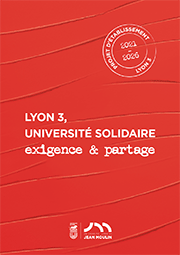AccueilRechercheLes productions scientifiquesThèsesThèses soutenuesThèses soutenues - 2006-2020Thèses soutenues - 2017
-
Partager cette page
- Recherche,
BELOT Dimitri
La durée de protection en droit d'auteur et droits voisins
Publié le 21 juin 2017 – Mis à jour le 14 novembre 2017
Thèse en Droit mention Droit international privé soutenue le 13 juin 2017.
The model of protection of works, whether is copyright or droit d’auteur, is now strongly criticized. Particularly regarding its duration. Why do we now have a seventy years post mortem auctoris term of protection of in France, in European Union and in the United States? In an era of constantly evolving Internet and dematerialized contents what are the risen current challenges for such a period of protection?
Answering these questions requires historical and legal "deconstruction" of the model in order to apprehend the current application of a term of protection of seventy years post mortem auctoris to the works.
While it is also important to understand recent developments in computation time, and in particular the different extensions of the term of protection, it is also fundamental to study the extension of the scope of copyright and droit d’auteur to certain types of works such as software or database.
Cultural lobbyists and many right holders play an important part in the current trend of an ever longer protection period. Therefore reasserting the value of public domain is now not only urgent, it’s capital. The economic analysis of the model shows that the duration of protection of works, which is today particularly long with regard to the current technological tools, impedes the spread of knowledge without, however, increasing the incentive to create. Thus, the protection model needs to be analyzed and rethought, both legally and economically, so that concrete reform of this model can be proposed.
gn: justify;">Le modèle de protection des œuvres de l’esprit, qu’il s’agisse du copyright ou du droit d’auteur, est aujourd’hui vivement critiqué. Notamment concernant sa durée. Pourquoi applique-t-on aujourd’hui une durée de protection de principe de soixante-dix ans post mortem auctoris aux œuvres de l’esprit en France, en Europe et aux Etats-Unis ? Et quels sont les enjeux actuels d’une telle durée de la protection à l’heure d’internet et des contenus dématérialisés ?
Pour répondre à ces questions, il est nécessaire de « déconstruire » historiquement et juridiquement le modèle, afin de comprendre l’application actuelle d’une durée de protection de principe de soixante-dix ans post mortem auctoris aux œuvres de l’esprit.
S’il est également primordial de comprendre les évolutions récentes des délais de computation et notamment les différentes prorogations de la durée de protection, il est aussi fondamental d’étudier l’élargissement du champ d’application du copyright et du droit d’auteur à certains types d’œuvres tels que le logiciel ou la base de données.
La volonté des lobbyistes de la culture et de nombreux ayants droit de proroger la protection des œuvres de l’esprit participe à la tendance actuelle d’une durée de protection toujours plus longue. Il y a donc urgence, et revaloriser de manière concrète le domaine public est aujourd’hui capital. L’analyse économique du modèle prouve que la durée de protection des œuvres de l’esprit, aujourd’hui particulièrement longue au regard des outils technologiques actuels, freine la diffusion du savoir sans toutefois augmenter l’incitation à la création Ainsi, le modèle de protection doit être analysé et repensé, aussi bien juridiquement qu’économiquement, afin qu’une réforme concrète soit proposée.
The model of protection of works, whether is copyright or droit d’auteur, is now strongly criticized. Particularly regarding its duration. Why do we now have a seventy years post mortem auctoris term of protection of in France, in European Union and in the United States? In an era of constantly evolving Internet and dematerialized contents what are the risen current challenges for such a period of protection?
Answering these questions requires historical and legal "deconstruction" of the model in order to apprehend the current application of a term of protection of seventy years post mortem auctoris to the works.
While it is also important to understand recent developments in computation time, and in particular the different extensions of the term of protection, it is also fundamental to study the extension of the scope of copyright and droit d’auteur to certain types of works such as software or database.
Cultural lobbyists and many right holders play an important part in the current trend of an ever longer protection period. Therefore reasserting the value of public domain is now not only urgent, it’s capital. The economic analysis of the model shows that the duration of protection of works, which is today particularly long with regard to the current technological tools, impedes the spread of knowledge without, however, increasing the incentive to create. Thus, the protection model needs to be analyzed and rethought, both legally and economically, so that concrete reform of this model can be proposed.
Answering these questions requires historical and legal "deconstruction" of the model in order to apprehend the current application of a term of protection of seventy years post mortem auctoris to the works.
While it is also important to understand recent developments in computation time, and in particular the different extensions of the term of protection, it is also fundamental to study the extension of the scope of copyright and droit d’auteur to certain types of works such as software or database.
Cultural lobbyists and many right holders play an important part in the current trend of an ever longer protection period. Therefore reasserting the value of public domain is now not only urgent, it’s capital. The economic analysis of the model shows that the duration of protection of works, which is today particularly long with regard to the current technological tools, impedes the spread of knowledge without, however, increasing the incentive to create. Thus, the protection model needs to be analyzed and rethought, both legally and economically, so that concrete reform of this model can be proposed.
gn: justify;">Le modèle de protection des œuvres de l’esprit, qu’il s’agisse du copyright ou du droit d’auteur, est aujourd’hui vivement critiqué. Notamment concernant sa durée. Pourquoi applique-t-on aujourd’hui une durée de protection de principe de soixante-dix ans post mortem auctoris aux œuvres de l’esprit en France, en Europe et aux Etats-Unis ? Et quels sont les enjeux actuels d’une telle durée de la protection à l’heure d’internet et des contenus dématérialisés ?
Pour répondre à ces questions, il est nécessaire de « déconstruire » historiquement et juridiquement le modèle, afin de comprendre l’application actuelle d’une durée de protection de principe de soixante-dix ans post mortem auctoris aux œuvres de l’esprit.
S’il est également primordial de comprendre les évolutions récentes des délais de computation et notamment les différentes prorogations de la durée de protection, il est aussi fondamental d’étudier l’élargissement du champ d’application du copyright et du droit d’auteur à certains types d’œuvres tels que le logiciel ou la base de données.
La volonté des lobbyistes de la culture et de nombreux ayants droit de proroger la protection des œuvres de l’esprit participe à la tendance actuelle d’une durée de protection toujours plus longue. Il y a donc urgence, et revaloriser de manière concrète le domaine public est aujourd’hui capital. L’analyse économique du modèle prouve que la durée de protection des œuvres de l’esprit, aujourd’hui particulièrement longue au regard des outils technologiques actuels, freine la diffusion du savoir sans toutefois augmenter l’incitation à la création Ainsi, le modèle de protection doit être analysé et repensé, aussi bien juridiquement qu’économiquement, afin qu’une réforme concrète soit proposée.
The model of protection of works, whether is copyright or droit d’auteur, is now strongly criticized. Particularly regarding its duration. Why do we now have a seventy years post mortem auctoris term of protection of in France, in European Union and in the United States? In an era of constantly evolving Internet and dematerialized contents what are the risen current challenges for such a period of protection?
Answering these questions requires historical and legal "deconstruction" of the model in order to apprehend the current application of a term of protection of seventy years post mortem auctoris to the works.
While it is also important to understand recent developments in computation time, and in particular the different extensions of the term of protection, it is also fundamental to study the extension of the scope of copyright and droit d’auteur to certain types of works such as software or database.
Cultural lobbyists and many right holders play an important part in the current trend of an ever longer protection period. Therefore reasserting the value of public domain is now not only urgent, it’s capital. The economic analysis of the model shows that the duration of protection of works, which is today particularly long with regard to the current technological tools, impedes the spread of knowledge without, however, increasing the incentive to create. Thus, the protection model needs to be analyzed and rethought, both legally and economically, so that concrete reform of this model can be proposed.
Mots-Clés : modèle, durée, protection, droit d’auteur, copyright, droits voisins, réforme
Keywords : model, duration, protection, droit d’auteur, copyright, droits voisins, reform
Directrice de thèse : Edouard TREPPOZ
Membres du jury :
- M. BINCTIN Nicolas Professeur agrégé - Université de Poitiers
- M. KAMINA Pascal Professeur agrégé - Université de Franche-Comté, Besançon
- M. PFISTER Laurent Professeur agrégé - Université Paris II Panthéon-Assas
- M. SIIRIAINEN Fabrice Professeur agrégé - Université Nice Sophia Antipolis
- M. TREPPOZ Edouard Professeur des universités - Université Jean Moulin Lyon 3
Président du jury : Pascal KAMINA
Equipe d'accueil : EDIEC
Décision : AdmisKeywords : model, duration, protection, droit d’auteur, copyright, droits voisins, reform
Directrice de thèse : Edouard TREPPOZ
Membres du jury :
- M. BINCTIN Nicolas Professeur agrégé - Université de Poitiers
- M. KAMINA Pascal Professeur agrégé - Université de Franche-Comté, Besançon
- M. PFISTER Laurent Professeur agrégé - Université Paris II Panthéon-Assas
- M. SIIRIAINEN Fabrice Professeur agrégé - Université Nice Sophia Antipolis
- M. TREPPOZ Edouard Professeur des universités - Université Jean Moulin Lyon 3
Président du jury : Pascal KAMINA
Equipe d'accueil : EDIEC
Documentation
Mise à jour : 14 novembre 2017



